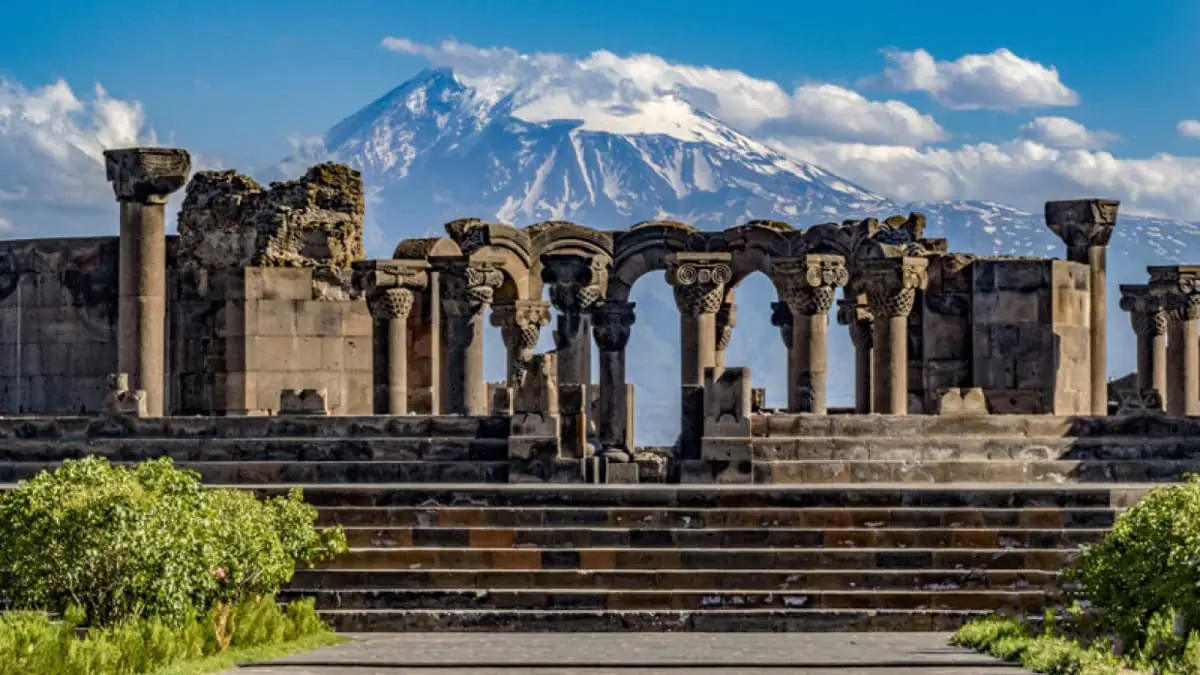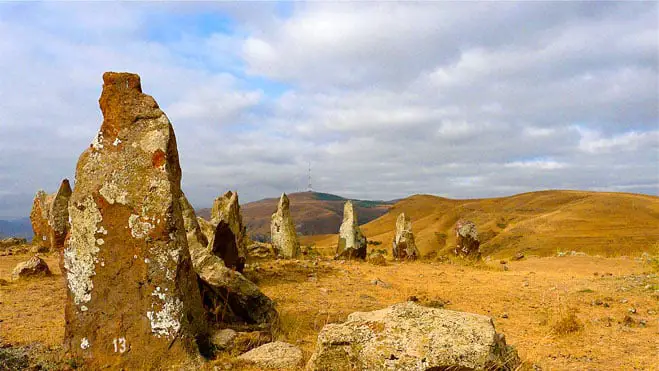When speaking the Armenian Language Today, Armenians worldwide don’t call themselves ”Armen.” We call ourselves Hay (sounds like “High”).
In our Native tongue, we don’t call our motherland Armenia. We call our country “Hayastan” (“astan” suffix meaning stan- country of). We speak the “Hay-eren” language (“eren” suffix for languages).
Proto- Armenians have called their homeland Hayasdan. Armenia was called Hayassa- Azzi (15th Century BC), Land Of Nairi, Land of Biaini, Kingdom of URARTU, or as it is called in the Bible, Kingdom of Ararat. After the arrival of the Indo-European tribes, including the Armens, between 7BCE and 6 BCE, they merged with the local indigenous Nairian tribes into a new nation.
The merging with the Indo- Europeans ended the great kingdoms in Asia Minor like the Hittites, the Haldi, and Mitanni. Eventually, new kingdoms came to power.
The proof is in the inscription and history of our neighbors. It was the Greeks and Iranians who first started calling us Armenians. Plato explains Aram means son of Armen.

Where Was Ancient Armenia Located?
According to scholar E. Forrer, Hayassa- Azzi was located in the western parts of the Armenian Highlands. He has discovered evidence of a treaty between The Hittites and Hayassa.
According to Nansen, Fridtjof (Gjennem Armenia. Oslo, 1927.) Ancient Armenia was located Around Lake Van, south of the Caucasian mountain range, including the Armenian Highlands and eastern Anatolia. That is extreme north-west of Asia, east of Anatolia, and north of the Middle East.
Is Armenia the Oldest Civilization?
Armenian history goes back as far as the first millennium BCE with the Stonehenges- the Karahunge, which is 7500 years old. Areni Winery has been estimated to be 6100 years old. The oldest shoe in history found in Armenia is 5500 years old. Let’s go after the Flood.
The Armenian Highlands are considered to be the very Cradle of Civilization. As it is mentioned in the Bible, the Land of Ararat or Urartu is where Noah’s Arc Landed. Biblically, Armenians are Noah’s son Japeth’s descendants.
700 years after the Flood, Hayk, our forefather, defeated the Babylonian king around 2492 BC. This means Karahunge is older than Stonehenge in England and the Pyramids of Egypt.

How Ancient are Armenians?
The Ancient Civilizations are the Sumer, Akkadian, Babylonian, Phrygian, Assyrian, Hittite, Roman, Parthian, Greek, Chinese, Egyptian, Danubian, and Mesopotamian (Medes, Chaldeans, Lydians) Civilizations.
According to a Greek myth, which reflects this tribal migration, the Armenians’ forefather of Armenians – Armenios – was one of the Argonauts, accompanying Jason in his quest for the Golden Fleece.
Armenians are part of the Ancient Civilizations because archaeological discoveries from Ancient Civilizations have mentioned Armenians.
In the year 1115 BC, king Tiglath Pileser I of Assyria reports a battle with a force of 20.000 Armens
in the Gadmokh province of Assyria.
The Sumerian Civilization mentioned the Land of Haya in 2700 BC. Greek Historian Herodotus speaks about Armenia around 450 BC. King Darius, I (the Great, r. 522-486 BCE) wrote when he took the throne of the Achaemenid Empire (c. 550-330 BCE) in 522 BCE:
Says Darius the king: These are the countries which came to me; by the grace of Ahuramazda I became king of them; Persia, Susiana, Babylonia, Assyria, Arabia, Egypt, the (lands) which are on the sea, Sparda, Ionia, [Media], Armenia, Cappadocia, Parthia, Drangiana, Aria, Chorasmia, Bactria, Sogdiana, Ga(n)dara, Scythia, Sattagydia, Arachosia, Maka; in all (there are) 23 countries.
The Behistun Inscription mentions Armenia in 522 BCE.
What is found in the land tells the real stories of the people that lived there. When Christianity was declared an official religion, temples were destroyed, and only Garni Stands today.
Later centuries of invasions and war resulted in losing a great deal of historical treasure. However, we have our neighbors to thank for telling our stories back to us.
Where Did Ancient Armenians Come From?
Some Scholars have said that Armenian are descendants of Phrygians who arrived from the Balkans, but recent DNA evidence proves their theory wrong.
“Findings at Karajunge tell us about a Megalithic migration of Armenians westward during pre-History, “ according to Croatian Historian O. Sakac. Opening the Ark of the Covenant co-author Laura Beaudoin
“They found it in the rotation of the heavens, that clockwork cosmos of unerring regularity by which humans could reorder their lives and bond again with the perennial forces of life. Accordingly, the first few generations of Mesopotamian immigrants in Armenia.”
There is evidence in Assyrian Archaeology that Urartu was the union of Nairian tribes of the region who united to defeat one Enemy. They built their capital Doushba around lake Van in addition to Arkishdikhinili and Mussasir.
Ancient Armenia (3500 BC – 520 BC)
The highly advanced Kingdom of Ararat (with the capital in Tushpa, today’s Van), is better known under its Assyrian name Urartu (Ararat).
This state was formed in the XI century BC and existed until VII century BC. Although populated mostly by Armenians, Urartu was ruled (at least during the first centuries) by a Pre-Armenian and non-Indo-European dynasty.
In 782 BC The Urartian King Argishti I found the fortified city of Erebuni, which is today’s Yerevan, the capital of Armenia.
Another major city in the Valley of Ararat was Argishti-Khinili, founded by Argishti in 775 BC
What was the first Armenian Kingdom called?
HAYASA(18-13 C BC)
What was the first Armenian Capital called?
VAN (DOSBI- DOUSHBA).
Who was the First Armenian King?
KING ARAM OR ARMENAK (2400 BC), SON OF HAIG
What happened to Urartu?
THEY MIXED WITH THE INDO-EUROPEAN TRIBES TO FORM THE ARMENIAN NATION

The mixture of Armens with the indigenous Hayasa
Eventually produced, the Armenian people as it is known today. The existence of two major segments of the Armenian people is best of all illustrated by the fact that Armenians call themselves “Hay” and their
country “Hayastan” after Hayasa, while other peoples call them Armenians and their country Armenia after the Armens.
The Armenian language is basically the language of Armens, which is the only survivor of the now extinct Thraco-Phrygian group.
It incorporated a large number of Hayasa words and grammatical features, as well as a
a significant number of non-Indo-European words from minority ethnic groups, which also
took part in the ethnogenesis of Armenians.
What Happened to the Kingdom of Urartu?
Weakened by Scythian invasions, it fell, but after several decades was revived under the Armenian Yervanduni (the Orontides) dynasty with the capital in Armavir, former Argishti-khinili.
The revived kingdom was already called Armenia by its neighbors, but in some languages, the older name, Urartu, was still in use.
In the famous tri-lingual Behistun inscription of the Persian king Darius the Great (522-486), the same country is referred to as ‘Armenia’ in the Persian and Elamite versions and ‘Urartu’ in the Akkadian version.
Artashisian dynasty, First Armenian Kingdom.
The Ancient Armenian Calendar
The Ancient Armenian Calendar- Domar goes back around 21 thousand years. The Old Armenian Calendar Domar is 4506 years old, it started with the victory of Haig over Pel in 2492 BC.
The year of the Old Domar consisted of 12 months (Named after Haig’s Children) and 5 Additional days (6 for Leap years). The year started on Navasart 1 (August 11). Each month consisted of 30 uniquely named days, the hours of the day also had 24 different names.
